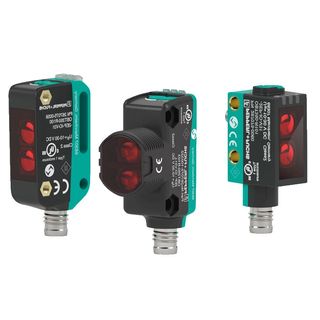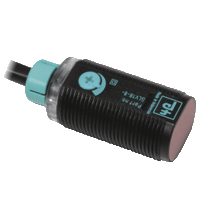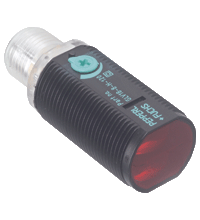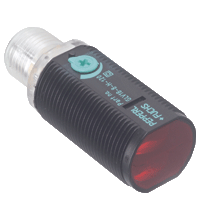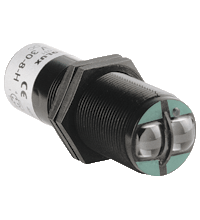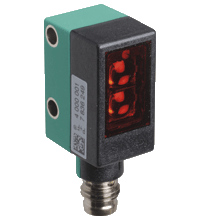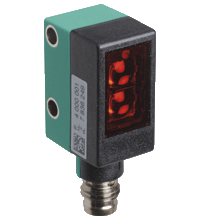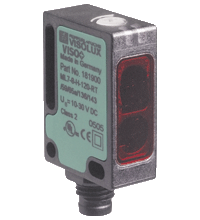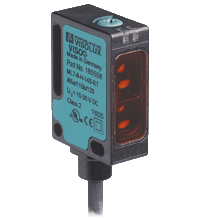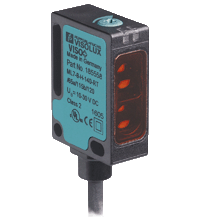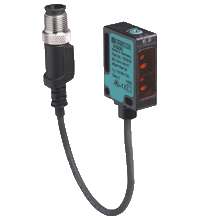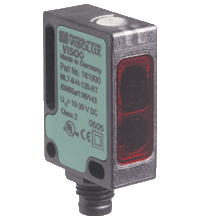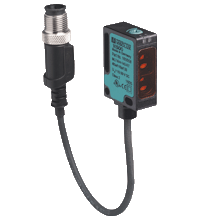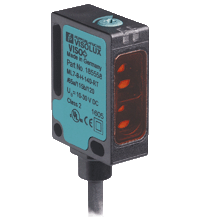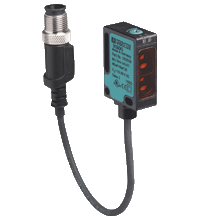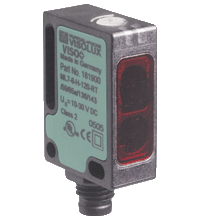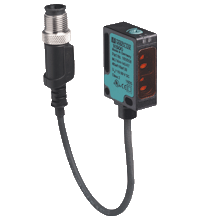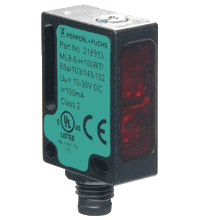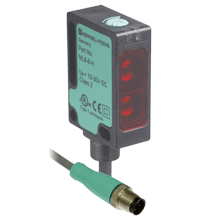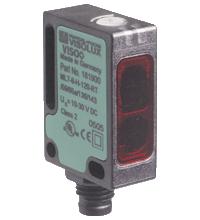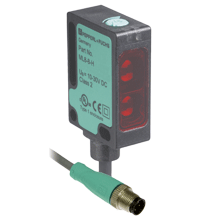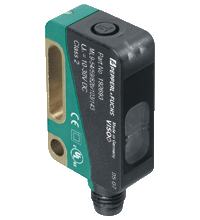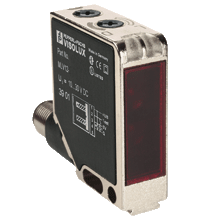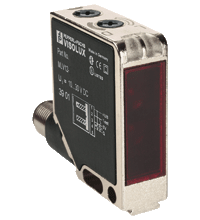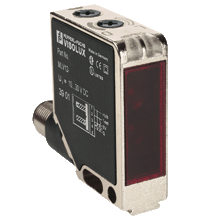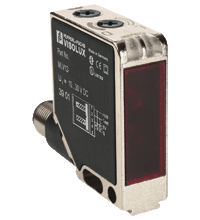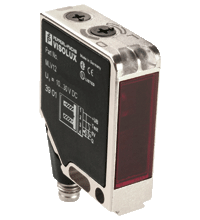Pepperl+Fuchs Background Suppression Sensors
- Efficient Line in a short M18 plastic housing for standard applications
- Best background suppressor in its class
- Minimal black-white difference
- 4 LEDs indicator for 360?° visibility
- Optimized potentiometer design for a clear control button layout in the application
- Efficient Line in a short M18 plastic housing for standard applications
- Best background suppressor in its class
- Minimal black-white difference
- 4 LEDs indicator for 360?° visibility
- Optimized potentiometer design for a clear control button layout in the application
- Efficient Line in a short M18 plastic housing for standard applications
- Best background suppressor in its class
- Minimal black-white difference
- 4 LEDs indicator for 360?° visibility
- Optimized potentiometer design for a clear control button layout in the application
- M30 plastic housing
- Dark-On switching
- Precise background suppression
- Very small black-white difference
- Small, sharp light spot
- Highly visible LEDs for Power-On, switching status, short-circuit, and undervoltage
- Metal-reinforced fastening holes
- Tamper-proof version with no adjustments
- NPN version
- Dual sensor with two Light spots
- Precise background suppression
- Very small black-white difference
- Light spot signals are directly connected to both independent switching outputs
- Short circuit and low voltage indicator
- Metal-reinforced fastening holes
- Tamper-proof version with no adjustments
- Miniature design
- Reliable detection of all surfaces, independent of color and structure
- Minimal black-white difference
- Precision background suppression, adjustable
- Clearly visible function indicators
- Short circuit and low voltage indicator
- Certified by ECOLAB
- Miniature design
- Reliable detection of all surfaces, independent of color and structure
- Minimal black-white difference
- Precision background suppression, adjustable
- Clearly visible function indicators
- Short circuit and low voltage indicator
- Certified by ECOLAB
- Miniature design
- Reliable detection of all surfaces, independent of color and structure
- Minimal black-white difference
- Precision background suppression, adjustable
- Clearly visible function indicators
- Short circuit and low voltage indicator
- Certified by ECOLAB
- Miniature design
- Reliable detection of all surfaces, independent of color and structure
- Minimal black-white difference
- Precision background suppression, adjustable
- Clearly visible function indicators
- Short circuit and low voltage indicator
- Certified by ECOLAB
- Miniature design
- Reliable detection of all surfaces, independent of color and structure
- Minimal black-white difference
- Precision background suppression, adjustable
- Clearly visible function indicators
- Short circuit and low voltage indicator
- Certified by ECOLAB
- Miniature design
- Reliable detection of all surfaces, independent of color and structure
- Minimal black-white difference
- Precision background suppression, adjustable
- Clearly visible function indicators
- Short circuit and low voltage indicator
- Certified by ECOLAB
- Miniature design
- Reliable detection of all surfaces, independent of color and structure
- Minimal black-white difference
- Precision background suppression, adjustable
- Clearly visible function indicators
- Short circuit and low voltage indicator
- Certified by ECOLAB
- Miniature design
- Reliable detection of all surfaces, independent of color and structure
- Minimal black-white difference
- Precision background suppression, adjustable
- Clearly visible function indicators
- Short circuit and low voltage indicator
- Certified by ECOLAB
- Miniature design
- Reliable detection of all surfaces, independent of color and structure
- Minimal black-white difference
- Precision background suppression, adjustable
- Clearly visible function indicators
- Short circuit and low voltage indicator
- Certified by ECOLAB
- Miniature design
- Reliable detection of all surfaces, independent of color and structure
- Minimal black-white difference
- Precision background suppression, adjustable
- Clearly visible function indicators
- Short circuit and low voltage indicator
- Certified by ECOLAB
- Miniature design
- Reliable detection of all surfaces, independent of color and structure
- Minimal black-white difference
- Precision background suppression, adjustable
- Clearly visible function indicators
- Short circuit and low voltage indicator
- Certified by ECOLAB
- Diffuse mode sensor with multiple light spots
- Specially designed for detecting critical objects such as PCBs
- Detects objects in front of a close background through precise background suppression
- Can be adapted to the application in question thanks to the adjustable detection range
- Precision object detection, almost irrespective of the color
- Not sensitive to ambient light, even with switched energy saving lamps
- Miniature design
- Minimal black-white difference
- Flexible mounting possibilities due to slotted hole
- Not sensitive to ambient light, even with switched energy saving lamps
- Protection class II
- Miniature design
- Minimal black-white difference
- Flexible mounting possibilities due to slotted hole
- Not sensitive to ambient light, even with switched energy saving lamps
- Protection class II
- Miniature design
- Minimal black-white difference
- Flexible mounting possibilities due to slotted hole
- Not sensitive to ambient light, even with switched energy saving lamps
- Protection class II
- Ultra bright LEDs for power on and switching state
- Flashing power on LED in case of short-circuit
- TEACH-IN
- Not sensitive to ambient light, even with switched energy saving lamps
- Protected against mutual interference (no cross-talk)
- Protection class II
- Reliable detection of all surfaces, independent of color and structure
- Minimal black-white difference
- Ultra bright LEDs for power on and switching state
- Flashing power on LED in case of short-circuit
- Powerful push-pull output
- Not sensitive to ambient light, even with switched energy saving lamps
- Multiple device installation possible, no mutual interference (no cross-talk)
- Protection class II
- Reliable detection of all surfaces, independent of color and structure
- Minimal black-white difference
- Ultra bright LEDs for power on and switching state
- Flashing power on LED in case of short-circuit
- Not sensitive to ambient light, even with switched energy saving lamps
- Multiple device installation possible, no mutual interference (no cross-talk)
- Protection class II
- Reliable detection of all surfaces, independent of color and structure
- Minimal black-white difference
- Ultra bright LEDs for power on and switching state
- Flashing power on LED in case of short-circuit
- Not sensitive to ambient light, even with switched energy saving lamps
- Multiple device installation possible, no mutual interference (no cross-talk)
- Protection class II
- Reliable detection of all surfaces, independent of color and structure
- Minimal black-white difference
- Ultra bright LEDs for power on and switching state
- Flashing power on LED in case of short-circuit
- Powerful push-pull output
- Not sensitive to ambient light, even with switched energy saving lamps
- Multiple device installation possible, no mutual interference (no cross-talk)
- Protection class II
- Reliable detection of all surfaces, independent of color and structure
- Minimal black-white difference
- Ultra bright LEDs for power on and switching state
- Flashing power on LED in case of short-circuit
- Powerful push-pull output
- Not sensitive to ambient light, even with switched energy saving lamps
- Multiple device installation possible, no mutual interference (no cross-talk)
- Special device for paper web break control and printing machinery
- Sensing range 20 mm ... 60 mm
- Light scanner with foreground suppression 0 mm ... 15 mm and background suppression beyond 70 mm
- Minimal black-white difference
- Sturdy aluminum housing
- Degree of protection IP67
Guide to Background Suppression Sensors
Pepperl+Fuchs was founded in 1945 and the company produces electronics. In particular, they produce electronics for industrial automation. The Pepperl+Fuchs product line includes a wide range of sensors. Today we decided to draw your attention to Pepperl Fuchs background suppression sensors.
Background suppression sensors, also known as background suppression distance sensors, are a type of optical sensor commonly used in industrial automation and manufacturing. These sensors are designed to detect the presence or absence of objects within a specified sensitivity range while suppressing the influence of background objects.
Background suppression sensors typically use optical technologies such as triangulation or time-of-flight to determine the distance to an object in their field of view.
The sensor emits a beam of light towards the target area and the receiver detects the reflected light. The time it takes light to travel to the object and back allows the sensor to calculate the distance.
Exploring the Technical Specifications and Features
Pepperl+Fuchs background suppression sensor technology offers users many useful features. Let's take a closer look at the technical specifications and features of such sensors.
Background suppression
The primary feature of these sensors is their ability to suppress the influence of background objects. They are designed to only detect objects within a specific distance range, ignoring background surfaces.
Adjustable sensing range
Many background suppression sensors offer adjustable sensing ranges, allowing users to set the detection distance based on the specific requirements of their application.
Compact design
These sensors often have a compact and space-saving design, making them suitable for installation in tight spaces or on machinery.
Digital output
Background suppression sensors typically provide digital output signals, indicating the presence or absence of an object within the set sensing range.
Response time
These sensors generally have fast response times, enabling quick detection of objects as they enter the sensing range.
Light source options
Depending on the model, background suppression sensors may use various light sources, such as infrared (IR) or visible red light.
LED indicators
Many sensors include LED indicators to provide visual feedback on the sensor's operational status, making it easier for operators to monitor.
Multiple applications
Background suppression sensors find applications in various industries, including.
- Conveyor systems. This industrial sensor technology is used for detecting objects on conveyor belts while ignoring the conveyor surface. This is critical in material handling and packaging applications where items need to be accurately detected as they move along a conveyor.
- Packaging and sorting. Such devices are applied in packaging lines to detect the presence of items and ensure proper sorting. Background suppression sensors help optimize sorting processes and prevent false detections from surrounding surfaces.
- Automated Guided Vehicles (AGVs). Background suppression sensors are integrated into AGV systems to provide obstacle detection capabilities. AGVs often use background suppression sensors to navigate and avoid collisions with objects in their path.
- Robotics. Such sensors are utilized in robotic applications for detecting objects in the robot's workspace. Background suppression sensors help robots identify and interact with objects accurately, improving the efficiency of automation processes.
- Assembly lines. These sensors are applied in assembly lines to detect the presence or absence of components at specific locations. Background suppression sensors help streamline assembly processes by ensuring that the right components are in the correct positions.
- Automotive manufacturing. Background sense devices are employed in automotive manufacturing for various applications, including part detection, quality control, and ensuring proper positioning of components on the assembly line.
- Printing and labeling machines. Background suppression sensors are integrated into printing and labeling machines to detect the presence of labels or packaging materials. This ensures accurate labeling and packaging in manufacturing processes.
- Food and beverage industry. Pepperl+Fuchs sensors are applied in food and beverage processing for object detection and sorting on production lines. Background suppression sensors help maintain efficiency and hygiene in food processing environments.
Installation and Configuration
Here are some general pieces of advice for the installation and configuration of precision sensing solutions by Pepperl+Fuchs.
- Mount the background suppression sensor at the desired location, ensuring it has an unobstructed view of the detection area. Follow the manufacturer's recommendations for the appropriate mounting height and orientation.
- Align the sensor according to the desired sensing direction. Ensure that the emitted light beam covers the target area without interference from surrounding objects.
- Use appropriate mounting hardware to securely attach the sensor to the mounting surface. Ensure that the sensor is stable and won't be subject to vibrations that could affect its performance.
- Consider the environmental conditions such as temperature, humidity, and potential exposure to liquids or chemicals. Ensure that the sensor is suitable for the intended operating environment.
- Connect the sensor to the power supply according to the manufacturer's specifications. Verify the correct wiring of the sensor's output to your control system.
- If the background suppression sensor has an adjustable sensing range, set it to the desired distance based on your application requirements. This is often done using a potentiometer or other adjustment mechanism on the sensor.
- Configure the sensor's threshold or switching point based on the characteristics of the objects you want to detect. This determines when the sensor outputs a signal.
- Set the desired output configuration (NPN or PNP) based on the requirements of your control system. Verify that the sensor's output is compatible with the input of your connected devices.
- Perform thorough testing to ensure that the sensor accurately detects objects within the specified range and ignores background surfaces. Adjust the settings if necessary.
- Pay attention to any diagnostic LEDs on the sensor. These indicators can provide information about the sensor's status and help troubleshoot any issues.
